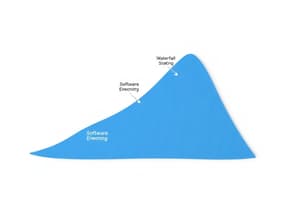Podcast
Questions and Answers
What is the primary purpose of unit testing during the coding and unit testing phase?
What is the primary purpose of unit testing during the coding and unit testing phase?
- To deploy the software to the end-user
- To verify that each module or function works correctly (correct)
- To ensure the software meets the specified requirements
- To test the software as a whole
Why might the Waterfall model not be suitable for projects with frequently changing requirements?
Why might the Waterfall model not be suitable for projects with frequently changing requirements?
- It requires frequent deployment to end-users
- It lacks structured approach to development
- Changes in requirements may require revisiting previous phases (correct)
- It does not involve unit testing
What type of testing involves ensuring that the software meets the specified requirements and functions correctly as a whole?
What type of testing involves ensuring that the software meets the specified requirements and functions correctly as a whole?
- System testing (correct)
- Unit testing
- Integration testing
- User acceptance testing
In which phase is the software installed on the user's systems and training is provided to ensure effective use?
In which phase is the software installed on the user's systems and training is provided to ensure effective use?
Which phase of the Waterfall model involves analyzing and documenting all project requirements?
Which phase of the Waterfall model involves analyzing and documenting all project requirements?
What is an ongoing phase that involves updates, bug fixes, and improvements to the software after deployment?
What is an ongoing phase that involves updates, bug fixes, and improvements to the software after deployment?
What is the primary focus of the System Design phase in the Waterfall model?
What is the primary focus of the System Design phase in the Waterfall model?
Which phase of the Waterfall model involves building the skeleton of the software and implementing its functionality?
Which phase of the Waterfall model involves building the skeleton of the software and implementing its functionality?
What is the key characteristic of the Waterfall model that makes it suitable for large-scale projects with well-defined requirements?
What is the key characteristic of the Waterfall model that makes it suitable for large-scale projects with well-defined requirements?
In the Waterfall model, which phase involves writing code to support the designed architecture?
In the Waterfall model, which phase involves writing code to support the designed architecture?
Flashcards are hidden until you start studying
Study Notes
Waterfall Model in Software Development
The Waterfall model is a linear, sequential approach to the software development lifecycle (SDLC) that is popular in software engineering and product management. It divides the software development process into separate phases, with each phase building upon the previous one. This model ensures a structured and organized approach to software development, making it suitable for large-scale projects with long timelines and well-defined requirements.
Sequential Phases of the Waterfall Model
-
Requirements Analysis and Specification: In this phase, all requirements of the project are analyzed and documented in a specification document. It is essential to consider any limitations and constraints, such as time, budget, and technology.
-
System Design: Based on the requirements analysis, the software's architecture and design are defined. This phase involves creating a high-level design that outlines the skeleton of the software and how information will be accessed.
-
Implementation: This phase involves building the skeleton of the software, including the creation of the foundation and the structure. The software's functionality is implemented, and the code is written to support the designed architecture.
-
Coding and Unit Testing: In this phase, the software's code is written and tested to ensure it meets the requirements and specifications. This includes unit testing, which verifies that each module or function of the software works correctly.
-
Testing: This phase involves testing the software as a whole to ensure it meets the specified requirements and functions correctly. This may include various types of testing, such as integration testing, system testing, and user acceptance testing.
-
Deployment: Once the software has been developed and tested, it is deployed to the end-user. This phase involves installing the software on the user's systems and providing training and support to ensure they can use the software effectively.
-
Maintenance: After deployment, the software is maintained to ensure it continues to function correctly and address any issues that may arise. This phase is ongoing and may involve updates, bug fixes, and improvements to the software.
The Waterfall model is beneficial for projects with well-defined requirements and a structured approach to development. However, it is essential to note that this model does not accommodate changes easily, and any change in requirements may require revisiting previous phases, which can lead to delays and increased costs. Despite its limitations, the Waterfall model remains a popular choice for large-scale projects where a sequential and organized approach is necessary.
Studying That Suits You
Use AI to generate personalized quizzes and flashcards to suit your learning preferences.




